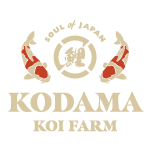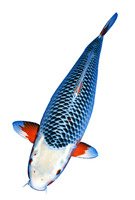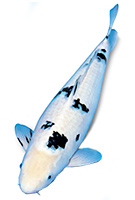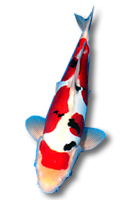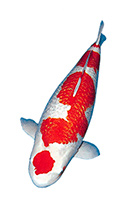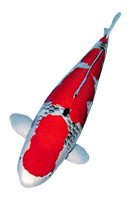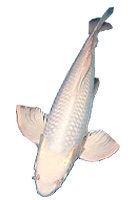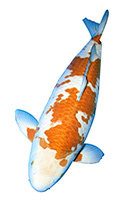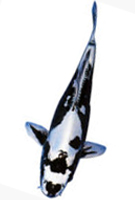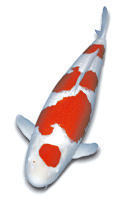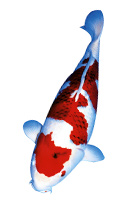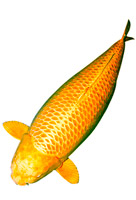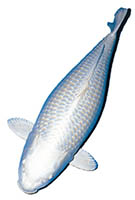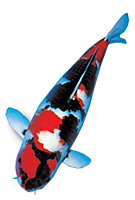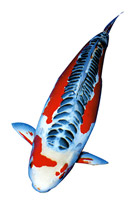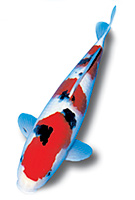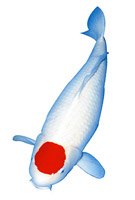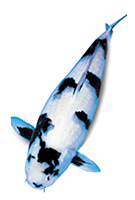Types of Koi Varieties
There are over a 100 different types of koi (Nishikigoi).
To find the proper koi classification you will need to look at their colors, patterns, and body confirmation. Each type of koi fish variety has it’s own specific details for identification and can be described based off another classification of Japanese Koi type.
For example, a Showa Sanke is a koi with calligraphic Sumi pattern on Kohaku and the Goshiki was created by breeding Asagi with Kohaku. Shusui, a type of Doitsu Japanese koi, is one of only two varieties of blue koi fish.
View popular koi varieties below and click to learn about each type of koi.
Types of Koi Fish Varieties Guide (PDF)
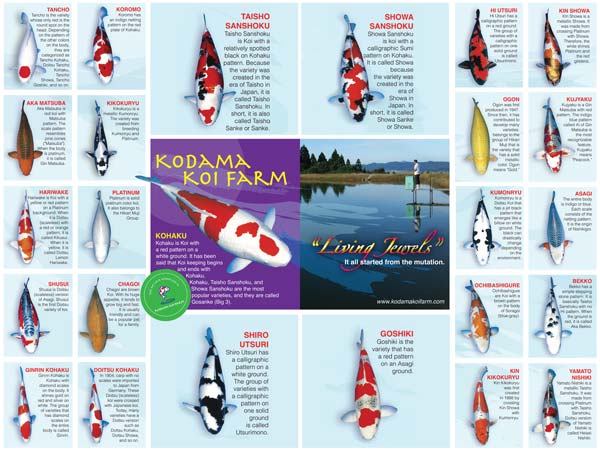
Download FREE Koi Variety Guide / Printable Poster:
Enter email to join our newsletter and receive koi variety guide printable file.
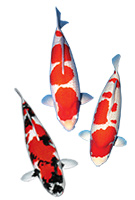
If you are interested in learning more, we recommend you read the history of Nishikigoi.
VIDEO - Top 9 Groups of Koi Types
Top Groups of Koi Types
When there are over 100 varieties in Koi, it is not easy to learn all of them one by one. It is easier to study the groups before you go into details of each variety. Here are the 9 main groups of Koi.
- Gosanke – Gosanke means Kohaku, Sanke and Showa. Gosanke in Japanese means the 3 most popular things within any group. Kohaku, Sanke and Showa are definitely the focal varieties of Koi. you can tell from the fact that grand champions of Koi shows always come from Gosanke group
- Utsurimono – This includes Shiro Utsuri, Hi Utsuri, Ki Utsuri and even Showa. These are basically black based Koi.
- Mujimono – The group of Mujimono or in short Muji means plain Koi. Koi such as Chagoi and Soragoi fall into this category.
- Hikarimono – Hikarimono means metallic Koi. Please be careful it is different from Ginrin. Hikarimono can be divided into 3 sub groups.
- 4-a One is Hikari-moyo. It is a metallic Koi with patterns such as Kujyaku.
- 4-b The next one is Hikari Utsuri. It is a metallic version of Utsurimono. Kin Ki Utsuri, Gin Shiro Utsuri, Kin Showa fall into this group.
- 4-c The last one is Hikari Muji. We learned Muji is a plain Koi. So Hikari Muji is metallic version of Mujimono. Ogon and Platinum are good examples.
- Kawarimono – Kawarimono in Japanese means oddballs. So in Koi, Kawarimono basically includes most of the varieties that do not blog to the other groups.
- Ginrin – Ginrin means silver scales. So Ginrin varieties are Koi that have glittering scales like diamond. Please be careful that ginrin is different from Hikarimono or metallic Koi.
- Doitsu – Doitsu Koi are scaleless Koi. It was developed by crossing scaleless food carp with Japanese Koi over 100 years ago. Doitsu means Germany in Japanese. It is because these scaleless carp were originally imported from Germany.
- Hirenaga / Butterfly – Hirenaga are the ones with long fins. They are also called butterfly Koi. It is not so popular in Japan, but it is very popular in Europe and in the US.
- Tancho – Tancho is any variety of Koi whose only pattern is a round spot on its head. The marking reminds us of Japanese flag. This is a very popular group. Please remember if you see other markings on the rest of the Koi body, the Koi is not called Tancho.
Types of Koi Varieties Common in Koi Shows
Most Popular Types of Koi for Shows
- Kohaku
- Taisho Sanke
- Showa
- Utsuri mono
- Bekko
- Asagi
- Shusui
- Koromo
- Goshiki
- Hikari Muji
- Hikari Moyo
- Hikari Utsuri
- Tancho
- Kin Ginrin
- Doitsu
- Kawari mono
How to Identify Different Koi Colors, Species, Names, Patterns
View Koi Colors, Species, Names, Patterns
Download our printable guide to see the top koi fish types, so you can easily reference and learn the different koi varieties. There are many koi species that may look similar, but are actually very different types of koi fish. The koi breeds are most commonly identified by their patterns, colors, and markings. Use our koi variety chart to better understand and identify the koi colours. You can also visit our website for koi the types and prices that fit your budget.
Top Japanese Koi Variety Identification Video
Watch Taro Kodama, explain the differences in koi varieties by their markings, colors, patterns, and history. View real examples of koi colors from Kohaku, Showa, and Taisho Sanke using actual koi images from our koi for sale. Get ready to learn about koi variety identification basics and why these types of koi are classified as Gosanke.
Send us a request for the koi variety and specifics you are searching for:
Fill out this form to tell us the price, variety, breeder, size, and even send pictures so we can help find the koi of your dreams!
List of All Koi Varieties & Types of Koi Classifications
Click each koi variety to see which we have available online and other examples of their patterns.
We have a large variety of koi on our website and here are the most popular types of koi fish in alphabetical order. View each image critically to see how the patterns of red, white, black, orange, and other colors paint a beautiful picture on the koi. Doitsu, Ginrin, and Tancho koi have many other subsets of varieties since for example Doitsu koi are all scaleless koi and Shusui—one of only two blue koi fish—is a type of Doitsu variety.
Read the descriptions of the different kinds of koi below to learn more about their…
- koi breeds
- koi fish colors
- koi fish kinds within breeds
- koi species
Asagi
Asagi are characterized by 1) a blue or indigo body, and 2) red at the base of the pectoral fins. The red at the base of the pectoral fins is called Motoaka.
Bekko
Bekko have only black and white colors in simple stepping stone pattern. There are no Hi (red) markings on this koi although it is bred from the Taisho Sanke koi.
Doitsu
Doitsu are German carp that are scale-less. Depending on the type of Doitsu, there may be scales along the lateral and dorsal lines of the koi or no scales at all.
Ginrin
Ginrin indicates the group of koi varieties that have diamond scales on the entire bodies. These scales are different from metallic and Platinum koi due to their scales being reflective and shining in the light in a miraculous way.
Goshiki
Goshiki was created in 1918 by breeding Asagi with Kohaku koi and truly shows a rainbow of colors. The black, blue, and grey colors appear in a netted pattern.
Hirenaga / Butterfly
Hirenaga koi are the butterflies of the water, and are known for their graceful, flowing fins. The long fins and tail of the Hirenaga should be solid without tears and ideally should be symmetrical.
Kawarimono
Kawarimono are nonmetallic koi that do not fit in to a class of fish like the others do. This is a broad variety of koi, and are all special and very unique.
Kikokuryu
Kikokuryu is essentially a metallic Kumonryu, a koi with shiny Platinum skin and fins with deep Sumi colors throughout.
Kohaku
It has been said that koi keeping begins and ends with Kohaku. In any variety that contains red patterns, it’s evaluated on an examination of its Kohaku pattern.
Koromo
Koromo are excellent koi and one to stand out. Koromo, means clothes or robe in Japanese and have a beautiful Hi (red) pattern of Kohaku on their pure white skin with an indigo blue pattern.
Ogon
Ogon, meaning gold, belongs to the Hikari Muji group. An Ogon is a solid-colored metallic koi, from silver to gold, and shines beautifully in a pond.
Platinum
Platinum koi can grow to be jumbo and are most treasured when they have a beautiful solid metallic shine with no blemishes or scars. They will shine beautifully in your dark pond with their almost reflective bodies.
Showa
Showa are beautiful koi, with colors of white, red, and black painted across their bodies. Showa are one of the Gosanke or “Big 3” koi fish along with Taisho Sanke and Kohaku koi. Before 1975, Showa were represented by the lineage of Kobayashi Showa.
Shusui
Shusui was the first Doitsu variety of koi and are one of the only two blue koi! They are a Doitsu (scale-less) version of Asagi. Shusui was first bred in the early 1900’s by Yoshigoro Akiyama mixing the Doitsugio, a German scale fish, and the Asagi.
Taisho Sanke
Taisho Sanke were developed from Kohaku about 80 years ago in 1918 in the era of Taisho. The Taisho Sanke, also called Taisho Sanshoku, pattern consists of three colors: white, red (Hi) and black (Sumi).
Tancho
Tancho are loved for many reasons including their resemblance to the Japanese flag and ability to stand out in a pond. They are named after the sacred red crowned crane of Japan for good fortune, love and long life.
Utsurimono
The base of their body is sumi (black), and utsuri means “reflection”. There are three beautiful varieties of Utsurimono including Hi (red), Shiro (white) or Ki (yellow).
We’ll be continuing to update this list of koi varieties, please request a koi if you can not find what you are looking for.
View All Koi Varieties Available
We have only the best Japanese Koi available. Take look through our inventory to choose the one that catches your eye!
Every koi has a special characteristic and only you know which is best for your pond.
Celebrating Japanese Koi Fish Kinds of All Shapes, Sizes and Colors
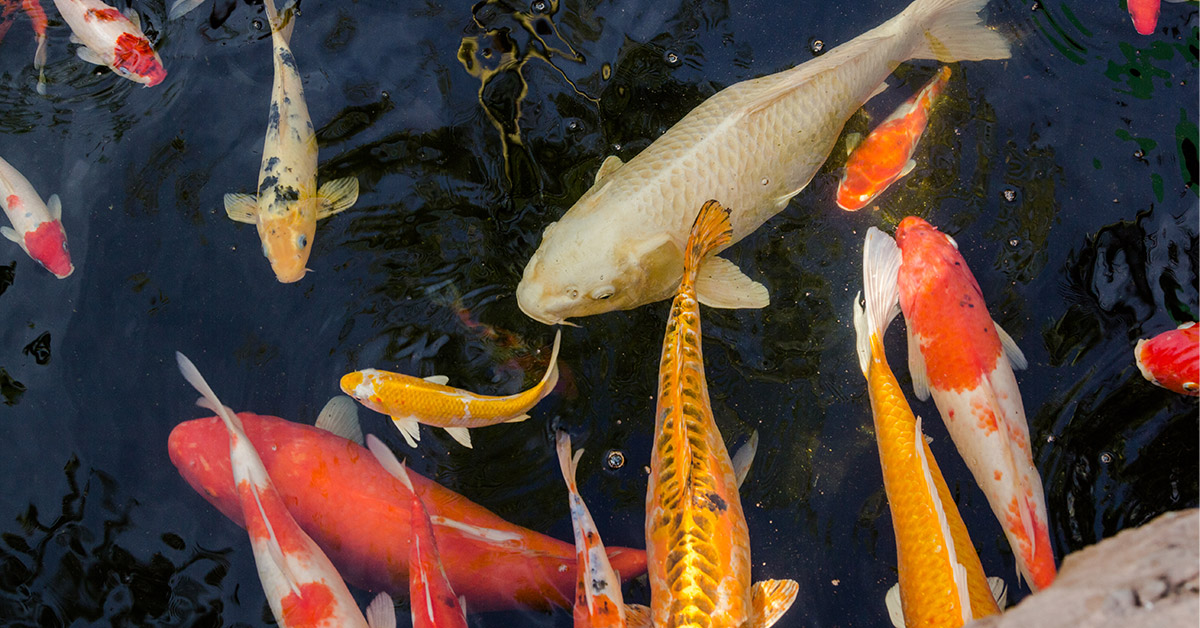
Diversity
Koi fish are not only beautiful but also come in a stunning array of colors, patterns, and varieties. From the classic Kohaku with its bold red and white markings to the elegant metallic Ogon, there’s a koi for every taste and preference.
Varieties and Types
Koi enthusiasts often categorize these fish into different varieties based on their color patterns and markings. Some of the most popular varieties include Kohaku, Taisho Sanke, Showa, Ogon, Bekko, Utsuri, Asagi, Shusui, and more. Each variety has its own unique charm and appeal.
Long History and Cultural Significance
Koi fish have a rich cultural history in Japan, where they are revered as symbols of luck, prosperity, and perseverance. Understanding the cultural significance adds depth to the appreciation of these magnificent creatures.
Personalities and Behaviors
Koi fish are known for their individual personalities and behaviors. Some are shy and reserved, while others are bold and outgoing. Observing their interactions in the pond can be a fascinating and rewarding experience.
Potential for Growth
Koi fish have the potential to grow quite large, sometimes reaching lengths of over three feet or more. It’s important for koi owners to be prepared for the long-term commitment and provide adequate space for their fish to thrive.
Artistry and Appreciation
Breeding and cultivating koi fish is considered an art form in and of itself. Breeders carefully select and cross different varieties to produce fish with desirable traits and characteristics. Appreciating the artistry behind each koi adds a whole other dimension.
Community and Camaraderie
The world of koi keeping is a vibrant and welcoming community of enthusiasts, hobbyists, and experts. Engaging with fellow koi lovers, sharing knowledge and experiences, and participating in koi shows and events can enhance the enjoyment of the hobby.
Educational Opportunities
Keeping koi fish offers valuable educational opportunities for people of all ages. From learning about water chemistry and biology of the pond fish to understanding the principles of genetics and selective breeding, there’s always something new to discover in the world of koi.
Joy and Serenity
Above all, koi fish bring joy, beauty, and serenity to our lives. Watching these graceful creatures glide through the water can be a source of relaxation and inspiration, connecting us to the natural world in a profound way.
